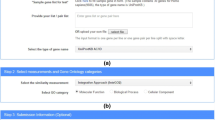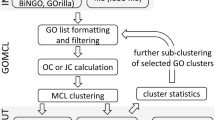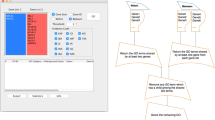Abstract
As a result of population and universality in high-throughput omics technologies in the last decade, such as microarray methods, many researchers who study their genes of interest that are similarly or differently expressed in cellular states, diseases, functional, or environmental element conditions have been possessed of the ability to identify biological validation on the genomic scale. In parallel with the advancement of omics experiments, the number of biological databases, which contain the biological annotations, genetic functionalities, metabolic pathways, and mutational information or functional interactions between genes or proteins, has increased. Fortunately, these datasets have been mainly opened to computational network protocols, such as FTP or SSH, and have freely served as web search tools to enable users to retrieve a biological annotation with queries. Of these databases, GO (Gene Ontology) provides controlled vocabulary terms for describing biological annotation of a gene or gene product in tree aspects that are classified as biological process, cellular component, and molecular function across various species. Also, GO gives researchers a publicly accessible tool for identification of a gene or gene product with GO terms. The result of this tool displays the hierarchical tree-type html format or DAGs (Directed Acyclic Graphs) graphtype format to users according to the three aspects of GO. However, as this permits users to ask only one keyword at a time, it is difficult to search many interesting gene sets in gene expression profiles obtained from microarray experiments at once. A few GO search tools have been developed to help in analysis of GO annotation for multi genes. However they have not satisfied user demands in terms of the simplicity of the user interface and visualization of analysis results. For these reasons, Array2GO, which has been based on a web environment, has been developed and is freely accessible at http://www.koreagene.co.kr/cgi-bin/service/service1.pl.
Similar content being viewed by others
References
Corsi, C., Ferragina, P. & Marangoni, R. The Bio-Prompt-box: an ontology-based clustering tool for searching in biological databases. BMC Bioinformatics 8(Suppl 1), S8(2007).
Wheeler, D.L. et al. Database resources of the National Center for Biotechnology Information. Nucleic Acids Res. 33(Database issue), D39–D45 (2005).
Bairoch, A. et al. The universal protein resource (Uni-Prot). Nucl. Acids Res. 33, D154–D159 (2005).
Bateman, A. et al. The Pfam protein families database. Nucleic Acids Res. 30, 276–280 (2002).
Berman, H.M. et al. The protein data bank. Nucleic Acids Res. 28, 235–242 (2000).
Kanehisa, M. et al. From genomics to chemical genomics: new developments in KEGG. Nucleic Acids Res. 34, D354–D357 (2006)
Ashburner, M. et al. Gene ontology: tool for the unification of biology. The Gene Ontology Consortium, Nat. Genet. 25, 25–29 (2000).
Shendure, J. & Ji, H. Next-generation DNA sequencing. Nat. Biotechnol. 26, 1135–1145 (2008).
Albaum, S.P. et al. A rich internet application to take a step forward in the analysis of mass spectrometry-based quantitative proteomics experiments. Bioinformatics 25, 3128–3134 (2009).
Gehlenborg, N. et al. Visualization of omics data for systems biology. Nat. Methods 7, S56–S68 (2010).
Berrar, D.P., Dubitzky, W. & Granzow, M. A practical approach to microarray data analysis. Kluwer Academic Publishers, 25–38 (2003).
Gene Ontology Consortium, The Gene Ontology in 2010: extensions and refinements, Nucleic Acids Res. 38(Database issue), D331–D335 (2010).
Khatri, P. & Drăghici, S. Ontological analysis of gene expression data: current tools, limitations, and open problems. Bioinformatics 21, 3587–3595 (2005).
Jones, C.E., Brown, A.L. & Baumann, U. Estimating the annotation error rate of curated GO database sequence annotations. BMC Bioinformatics 8, 170 (2007).
Rogers, M.F. & Ben-Hur, A. The use of gene ontology evidence codes in preventing classifier assessment bias. Bioinformatics 25, 1173–1177 (2009).
Grossmann, S., Bauer, S., Robinson, P.N. & Vingron, M. Improved detection of overrepresentation of Gene-Ontology annotations with parent child analysis. Bioinformatics 23, 3024–3031 (2007).
Carbon, S. et al. AmiGO: online access to ontology and annotation data. Bioinformatics 25, 288–289 (2008).
Bauer, S., Grossmann, S., Vingron, M. & Robinson, P.N. Ontologizer 2.0-a multifunctional tool for GO term enrichment analysis and data exploration. Bioinformatics 24, 1650–1651 (2008).
Graph Visualization Software [http://www.graphviz.org/].
Huntley, R.P. et al. QuickGO: a user tutorial for the web-based Gene Ontology browser. Database (Oxford), bap010 (2009).
Pontius, J.U., Wagner, L. & Schuler, G.D. UniGene: a unified view of the transcriptome. In: The NCBI Handbook, National Center for Biotechnology Information (2003).
The UniProt Knowledgebase (UniProtKB) [http://www.uniprot.org/help/uniprotkb].
Drysdale, R. & FlyBase Consortium. FlyBase: a database for the Drosophila research community. Methods Mol. Biol. 420, 45–59 (2008).
The Ensembl Project [http://www.ensembl.org].
Pruitt, K.D., Tatusova, T. & Maglott, D.R. NCBI Reference Sequence (RefSeq): a curated non-redundant sequence database of genomes, transcripts and proteins. Nucleic Acids Res. 35(Database issue), D61–D65 (2007).
Conesa, A. & Götz, S. Blast2GO: A comprehensive suite for functional analysis in plant genomics. Int. J. Plant Genomics 619832 (2008).
Pirooznia, M., Habib, T., Perkins, E.J. & Deng, Y. GOfetcher: a database with complex searching facility for gene ontology. Bioinformatics 24, 2561–2563 (2008).
The Comprehensive Perl Archive Network [http://search.cpan.org/].
ChartDirector [http://advsofteng.com/].
Fedora [http://fedoraproject.org/].
MySQL [http://www.mysql.com].
Apache [http://www.apache.org].
Author information
Authors and Affiliations
Additional information
An erratum to this article can be found at http://dx.doi.org/10.1007/s13206-011-5114-3
Rights and permissions
About this article
Cite this article
Kim, J.S., Kim, S.J., Lee, S.Y. et al. Array2GO: a simple web-based tool to search gene ontology for analysis of multi genes expression. BioChip J 4, 329–335 (2010). https://doi.org/10.1007/s13206-010-4410-7
Received:
Accepted:
Published:
Issue Date:
DOI: https://doi.org/10.1007/s13206-010-4410-7




